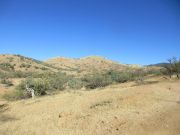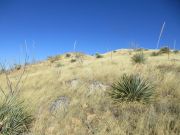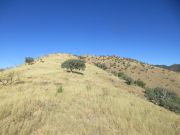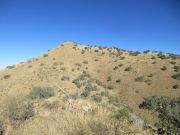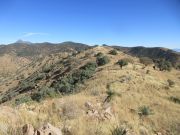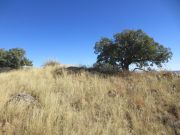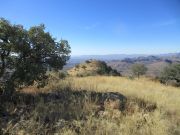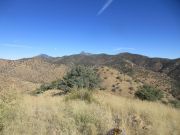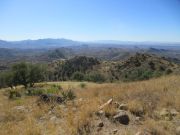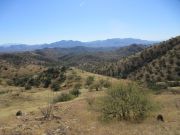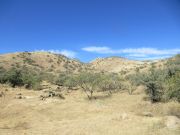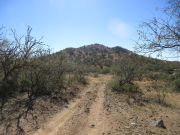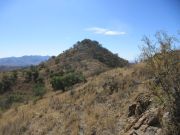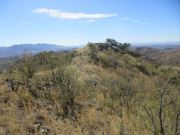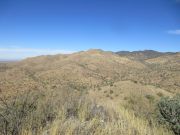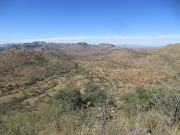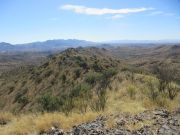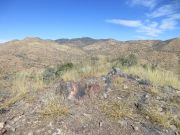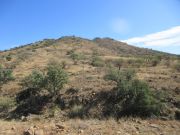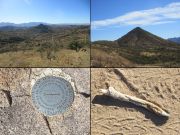
The Mountains of Arizona
www.surgent.net |
|
Santa Rita Peak • Peak 5077 Santa Rita Peak lies at the south edge of the Santa Rita Mountains, about ten miles northwest of Patagonia in Santa Cruz County. The peak used to be known as Squaw Peak but was changed to its current name in 2022. I wanted a hike this weekend, and a storm was expected for Sunday, so I headed out today, Saturday, for a morning of fun and adventure. I hoped for a hat trick of peaks: this peak, and two unnamed ranked peaks to the south, both with convenient road access, going by the maps. The weather had finally cooled to where it's actually cold in the morning and cool in the day. I left Bisbee around 6:15 a.m. and was in Patagonia about an hour later, with a stop at the market in Sonoita for drinks and snacks. Today was looking to be a fine day, cloudless and calm. Temperatures for now were in the 40s. In Patagonia, I followed local streets to get onto Blue Haven Road, which is a graded dirt road that heads west out of the small town a few miles through dense trees and brush. I saw a few locals rding their bicycles and jogging as I poked along. The road then bends right (northwest), now named Salero Canyon Road. This road was a little rougher but still a good graded road. It gained elevation, sometimes steeply, for a couple more miles. I was soon in the foothills of the Santa Rita Range. Santa Rita Peak is the farthest north of the three peaks. I planned to hike it first, then the other two on the way out. Salero Canyon Road lies on private lands and crosses Coronado National Forest land briefly where it bypasses the Weatherhead Ranch. The road gets one more notch rougher. Any vehicle with reasonable high clearance would be fine. The road is designated FR-143 while on the forest property. Santa Rita Peak comes into view in bits and pieces but not really in full view until the last mile. The road gains a long slope and achieves an apex before descending. Where the main road (FR-143) makes a left going westbound, the much-rougher FR-144 goes right. I drove in about 50 feet and parked in a clearing. There was no way my Soob was going to mess with the rocks on this road.
Date: November 2, 2024
• Elevation: 5,784 feet ✳
• Prominence: 467 feet
• Distance: 4 miles
• Time: 3 hours and 30 minutes entire hike
• Gain: 1,170 feet
• Conditions: Beautiful Fall weather, blue skies, cool, no clouds
Arizona
•
Main
•
PB
•
LoJ
•
USGS BM Datasheet
•
Lidar
It was close to 8 a.m. when I got properly dressed and packed for the hike. The sun was up and temperatures were in the low 50s. A foreground ridge blocked the view of most of Santa Rita Peak from where I parked.
I started walking FR-144, which gained gently, bending northeast then north. Once past the first ridge, I could see the whole peak in all its glory. It is a nice-looking peak with open grassy slopes and just a smattering of trees in places, not covered over in thick forest everywhere.
I walked in about a half mile, then found a cattle path that left the road and gained onto a low ridge coming off the peak. It looked good so I followed it. The path allowed me to make good time through the grass and scattered trees, predominantly mesquite.
This ridge gained more distinction and steepened to meet the slope up ahead. Looking up, I had a long unbroken grassy slope leading up to a point on the skyline. I knew this was not the summit, but it was still up there, about 700 feet higher relative to the road.
I just put my head down and trudged up the slope, following lanes and not thinking about too much. This segment took about fifteen minutes. Toward the top, I came upon a fence line that looked new, the wires taught and everything still standing. I found a low-point and stepped over it and was soon on this first false summit.
At this false summit I had a better view of the upper slopes and my first view of the actual highpoint. The summit features two bumps, the highpoint being north of the two (to the right as I looked up). The southern bump appears closer and thus, higher. It is also the location of the old "Squaw" benchmark.
I had to drop about forty feet, the terrain here a little rockier and brushier. I then had to gain up another steep slope to a second rocky knob, false summit number 2. Once on it, I dropped again about 40 feet, then marched up the last slope to put me on the southern bump, the one with the benchmark. The real highpoint was about a hundred yards away, about five or six feet higher.
I took a few moments to search for the benchmark but could not locate it. All I found was one witness marker. The data sheet does not list a recovery of the benchmark past 1972.
I then walked over to the true highpoint and sat on a rock near the highpoint rock outcrop. I found a register and signed in. There had been a couple groups up here in 2024, one being the Grass Valley Hiking Club. The register went back many years but was still mostly legible.
It had taken me one hour and twenty minutes to get here, a gain of 1,170 feet not including the two drops and regains. The one-way mileage came out to a little over two miles. It was an easy but tiring hike, being consistently steep for most of the last two-thirds. The views were fantastic and the weather was so good that I took a longer break to just sit and be in the moment.
Looking north, the two rocky summits of Mounts Hopkins and Wrightson poke above a long ridge. To the west was San Cayetano Peak and the Grosvenor Hills. To the south were Red Mountain with the lookout, and Washington Peak. To the east, I could see as far as the Huachucas and the Mustang Range.
After about ten minutes, I started down. I wasn't eager to go up and over those two false summits, and on the uphill, I had looked over at the ridge to the east, which appeared to be just one long steep slope. So I decided to follow that down.
The downhill hike went well. This descent ridge was steep and I had to move carefully to keep from suddenly skiing on the rubble. But footing was mostly good and the brush light. After about twenty minutes, I was below the steepest segments and now on the lower gentler ridges, but now dealing with small canyons and arroyos, which were brushier.
After a few minutes of battling the brush, I was suddenly back to the road. I did not see it until I was literally feet from it. I was on the road about a quarter-mile north of where I had left it about 90 minutes ago.
I walked the road until I was closing in on Peak 5077. When I was near Bull Tank, I started up the slopes...
Elevation: 5,091 feet ✳
• Prominence: 380 feet ✳
• Distance: 1 mile
• Gain: 430 feet
• Conditions: Still lovely
PB
•
LoJ
...of Peak 5077. I just picked one at random. The slopes were more brushy than grassy, more low trees and pointed plants than the lovely grass over on Santa Rita Peak.
I gained to a low ridge, which I followed up. It bent right, going south, aiming for a highpoint, which I knew was not the summit. I came upon a fence and followed it, there being a good path alongside it much of the way.
This allowed me to side-hill past the lower bump. I then scampered up to a saddle, now below the true top of this little peak.
The final hundred feet was steep and brushy, heavy enough to force me to find ways through or around it. Most of it was knee high but full of small thorns.
The very top was rockier, but I was soon on top ... only to see the real top just a few yards ahead. I walked over to it and sat down, mission complete. The top itself is bare and rocky. There was no register and no indication of past visitors. I know it's been climbed before, but likely by no more than a half dozen people.
The views were good here too, the weather staying steady. I sat for a few minutes to rest and enjoy the scenery. Naturally, I got a fine view of Santa Rita Peak from this higher vantage point.
Going down, I descended to the lower saddle, then followed game paths around the lower bump to its west. This put me on a long slope that led downward. I was now off the peak and within some arroyos and low hills. I stayed on a cow path and luckily, it fed me almost exactly back to my car.
This side trip did not take long, a half hour perhaps, and added about a mile to my day. I enjoyed the brief climb, but it's not really worth the trouble unless you have a deep internal need to get as many peaks as you can.
I was back to my car at 11:30 a.m., meaning I had been gone overall for 3 hours and 30 minutes. I was feeling very good, and conditions were still fantastic. I stayed in my hiking clothes and decided to go look at Peak 4862, the third peak on my agenda.
The best way to approach this peak would be from the northwest, but here, it is private land, with fences and pens and animals. There would be no way to stash my car and stealth it. The frustrating thing is that the National Forest boundary is just a few dozen yards to the east. But I'd have no choice but to park on the private land and trespass, even if for just a few minutes.
I drove south and took a look at it from that way. By now, I had dropped some more elevation and from the south, I'd be dealing with some deep-cut arroyos. I decided to skip this last peak.
I drove back to Patagonia and parked at the city park, and looked on my phone. I was still feeling energetic for another quicky peak. I saw that Sanford Butte is close by so I drove to it. It lies on land belonging to the Circle Z Dude Ranch. I am not sure their policy for day use, but there was no way to find out right there (just me and the gate).
I figured I had a good day, so I headed back home. I stopped in Sierra Vista for a small grocery and sundry run, and to see how many of the shoppers are shopping in their jammies. I was back in Bisbee about 2 p.m..
The maps do not give a summit elevation for Santa Rita Peak, but the 1-meter Lidar data says it's 5,784 feet high. For Peak 5077 (its elevation as printed on the map), it returned a value of 5,091 feet, a full 14 feet of difference. That's a fairly large difference. I use that figure here but keep the "Peak 5077" map name.
|
|
